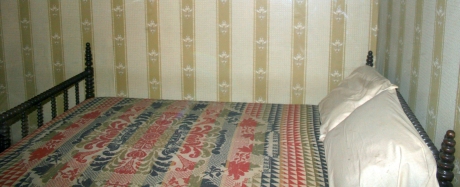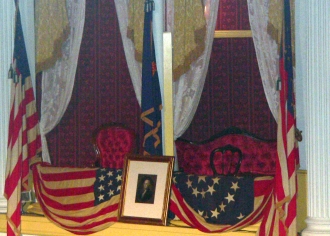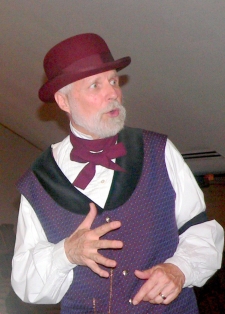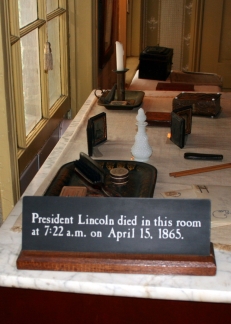Ford's Theatre National Historic Site and the Petersen House (HWLD)
Part of National Mall and Memorial Parks
Part of Pennsylvania Avenue NHS
Washington, D.C.
Visited: July 14, 2006
NPS Site Visited: 313 of 353
NPS Website; Local Website

WHAT IS IT?
Fordís Theatre is an active theatre infamously remembered as the place where, on April 14, 1865, John Wilkes Booth shot and killed President Abraham Lincoln during a performance of Our American Cousin. Once shot, Lincoln was carried next door to the Peterson House where he would later die.
BEAUTY (3/10)
Neither Fordís Theatre nor the Peterson House has a striking exterior. Be thankful for the signs, Rangers and the steady stream of entering tourists to distinguish them from the other brick buildings on 10th street.
The interiors of both have been carefully reconstructed to their 1865 appearances. Lots of dark colors and velvet-y drapes in the theatre; plenty of uncomfortable looking furniture and narrow hallways at Peterson. We are guessing that little has been done to alter the appearance of the Peterson House since its most famous guest passed away.
HISTORIC SIGNIFICANCE (8/10)
In the Peterson House, a/k/a House Where Lincoln Died, a/k/a HWLD, you can see the Bed Where Lincoln Died (BWLD) in the Room Where Lincoln Died (RWLD) overlooking the Courtyard of the House Where Lincoln Died (COTHWLD).
Did the fateful shot at Fordís Theatre save Lincoln from being associated with the failures of Reconstruction, or did it steal a great leader away from a nation when it needed him most? Either way, Fordís Theatre was the backdrop for a tragedy that altered the history of the United States.
 A very popular 1860s venue, Fordís Theatre was closed down by the federal government during the investigation and subsequent trial of the conspirators. After that, John Ford was allowed to reopen but was plagued with threats of arson and destruction. The War Department temporarily shut down the Theatre, leased the building from Ford as office space and then finally decided to take it off his hands for $100,000 in 1865. The collection of Lincoln memorabilia was added in 1926 and restoration efforts began in earnest in the 1960s. Today, the Theatre enjoys life as both a National Historic Site and a fully functioning theatre for contemporary American drama. A very popular 1860s venue, Fordís Theatre was closed down by the federal government during the investigation and subsequent trial of the conspirators. After that, John Ford was allowed to reopen but was plagued with threats of arson and destruction. The War Department temporarily shut down the Theatre, leased the building from Ford as office space and then finally decided to take it off his hands for $100,000 in 1865. The collection of Lincoln memorabilia was added in 1926 and restoration efforts began in earnest in the 1960s. Today, the Theatre enjoys life as both a National Historic Site and a fully functioning theatre for contemporary American drama.
CROWDS (7/10)
Being a site for public gatherings and stage performances, Fordís Theatre by its very nature can handle a good deal of people without problems. Exhibits in the basement museum are all encased in clear rectangular columns to allow for optimum viewing by the largest number of people possible.
Enjoy your elbow room at the Theatre because the Peterson House is another story. Crowds, and by crowds we mean more than 3 people, can easily clog the houseís narrow hall and limit your views of the parlors and famous BWLD. You may want to coordinate your entrance to the number of people you see exit.
EASE OF USE/ACCESS (5/5)
Fordís Theatre NHS is less than three blocks from all five D.C. Metro rail lines. The nearest station is Metro Center (blue, orange and red lines), located two blocks to the west. Gallery Place-Chinatown (green, yellow and red lines) is three blocks to the northeast.
Street parking could get tricky but there are plenty of nearby parking garages.
 CONCESSIONS/BOOKSTORE (4/5) CONCESSIONS/BOOKSTORE (4/5)
Full shelves carry over a hundred stories about the Civil War, the Assassination and all other aspects of old Abe. There is a much better selection here than at the Lincoln Memorial; more room to move too. Posters, photos and guides of the Capital city round out the bookstore offerings. Be sure to save room in your Passport Book for the FOUR stamps you can get here.
COSTS (5/5)
Whatís the best part about Washington, D.C.? Nearly every museum is free!
Our visits to Fordís Theatre have always been greeted by impromptu (and free) Ranger tours, programs and talks.
RANGER/GUIDE TO TOURIST RATIO (5/5)
Open the door to Fordís Theatre and you will see at least three Rangers ready to answer your ďhow much does it costĒ question with a smile and ďnothing at all!Ē We heard the cost inquiry at least a half-dozen times; these Rangers make so many people feel happy every day.
TOURS/CLASSES (8/10)
Fordís Theatre remains the same. Plays are still held, the balcony still provides the same views of the stage and American flags are still draped over the presidentís box. So it becomes pleasantly disconcerting when you climb the stairs and see a man in period costume recounting, in convincing first-person as the D.C. chief of police, the assassination and the subsequent hunt for conspirators. Waves of tourists blasted the Ranger with an endless and fascinated stream of questions. What a perfect way to learn about the caseís basic facts.
The Fordís Theatre basement museum is a treat for history buffs and CSI-watchers alike. It must hold the most macabre set of artifacts in all of D.C. including: Lincolnís blood stained overcoat; the guns Booth carried and presumably the one he shot Lincoln with; ticket stubs from the April 14, 1865 performance; the hoods worn by Boothís co-conspirators when they were hung and; the knife with which Booth stabbed Henry Rathbone. Amazingly, they are all originals.
FUN (8/10)
A visit to Fordís Theatre NHS and the HWLD is low effort, high reward. Two free sites in a one block radius, close to Metro stops and many lunchtime options. It doesnít get easier than this. Heck, you might not have even meant to come here but found yourself beckoned inside by one of many Rangers as you were walking to an event at the MCI Center or to the newly reopened Portrait Gallery. Go in! Go in! We were highly entertained by the highly biased retelling from the D.C. chief of police and were amazed once again by the vast collection of original items downstairs. The Peterson House is so close by that it is a mandatory stop. You canít watch just half the plot, can you?
 WOULD WE RECOMMEND? (9/10) WOULD WE RECOMMEND? (9/10)
You bet. Fordís Theatre NHS and the Peterson House (HWLD for those in the know) are two of the more interesting D.C. sites Ė something actually happened here. You can get your fill of crime, tragedy, intrigue and justice all without leaving the Theatre; the HWLD is a subdued denouement to the action. The shooting of Lincoln and capture of Booth and his colleagues plays out just like a modern day police drama. In his death, the martyred hero loses his faults and becomes larger than life and the bad guys get caught.
TOTAL 62/80
|